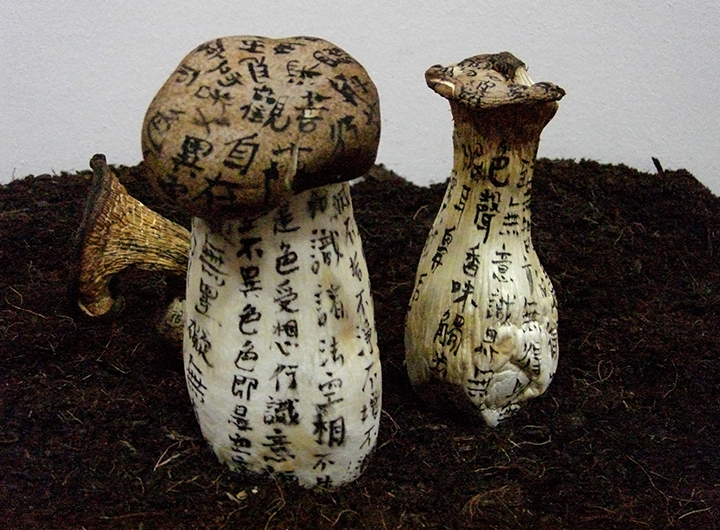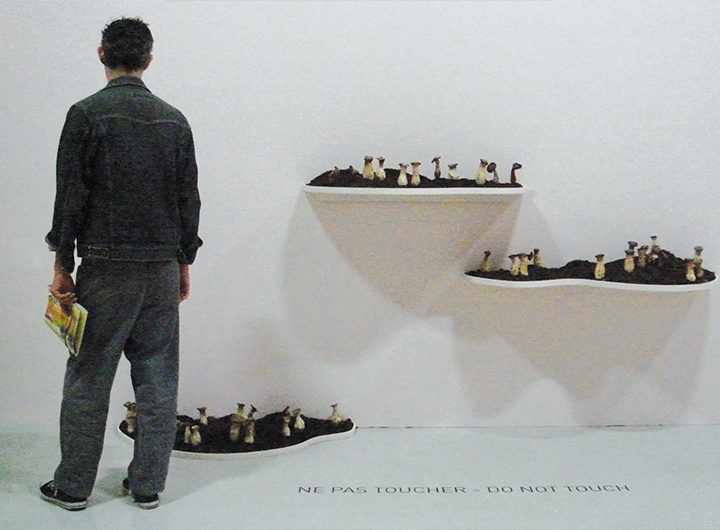Curated by Jean de Loisy
Pompidou Center, Paris, France
7 May to 11 August 2008
Exhibited Work:
Mushroom Mantra, 2009, Ephemeral installation for the exhibition


Press Release:
With “Traces du Sacré,” already promising to be one of the major artistic events of the year, the Centre Pompidou returns to the tradition of major multidisciplinary exhibitions that made its reputation, offering a visual exploration of one of the most pressing issues of our time.
Following what has come to be called “the disenchantment of the world,” a significant strain of modern art has found its roots in the turmoil attendant upon the loss of conventional religious belief, a terrain that continues to nourish the development of contemporary forms.
Taking in the whole history of twentieth-century art, from Caspar David Friedrich to
Kandinsky, from Malevich to Picasso, and from Barnett Newman to Bill Viola, the exhibition looks at the way in which art to continues to testify, in often unexpected ways, to the existence of a universe beyond, remaining, in a thoroughly secularised world, the profane vehicle of an ineluctable need to rise above the quotidian.
This broad selection of paintings, sculptures, installations and videos brings together some 350 major works – many of them never seen before in France – by almost 200 artists of international renown.
The distinctively multidisciplinary character of the exhibition will be reflected in the Centre’s regular ancillary events, with a programme of film, video and live performance, a lecture series and a literary colloquium expanding on the theme.
The exhibition is accompanied by a book and a catalogue, both published by Éditions du Centre Pompidou.
After Paris, the exhibition will travel to the Haus der Kunst in Munich (Germany),
19 September 2008 – 11 January 2009.
THE CONTEXT OF THE EXHIBITION
A distinctive feature of the human species, art makes its appearance in prehistory in close connection with our fundamental concern with the questions of what we are, where we come from, and where we are going.
This link between artistic creation and spiritual uncertainty has been manifest in all the great religions. Since the eighteenth century, however, the West has seen a profound transformation in the relationship between art and religion. The Reformation, the rise of capitalism, the ideals of the Enlightenment, the worship of Reason and the growth of the town all led to what Max Weber called “the disenchantment of the world.”
At the same time, the sense of the withdrawal of the divine that found expression in the Romantics, followed later by Nietzsche’s announcement of the death of God, the advance of science, the emergence of psychoanalysis and the growing influence of Marxism, led to a reconsideration of Man’s place in creation and thus of his relationship to the religious.
It was in this landscape of belief violently unsettled that Modern art came to birth.
If in the course of this long process the secularisation of society delivered artists from their subordination to the Church, the crisis of religion did not at all mean the disappearance of metaphysical questioning. The argument of this exhibition is that a significant strain of modern art has its roots in such concerns.
The goal of the exhibition is thus to explore the significance of the survival of such questioning throughout the twentieth century, and to show that it continues to fuel the invention of contemporary artistic forms, and as such represents an essential key to the understanding of modern art.
In collaboration with the Centre Pompidou, the Centre Culturel Suédois presents the exhibition “Hilma af Klint, une modernité révélée,” 11 April – 20 July 2008 (Curators: Anna-Maria Svensson, Jean de Loisy and Angela Lampe).
Works by Hilma af Klint are also included in the exhibition “Traces du sacré.”
Centre Culturel Suédois, 11 rue Payenne, 75003 Paris.
ORGANISATION OF THE EXHIBITION
The exhibition is chronologically organised by thematic sections that successively examine the major aesthetic and spiritual preoccupations of the twentieth century. Each of these twenty themes is also echoed in a contemporary work, demonstrating the continuing actuality of these concerns.
Introduction
Francisco Goya, Bruce Nauman, Christian Boltanski, Mounir Fatmi
Traces of the Fugitive Gods
Caspar David Friedrich, Carl Gustav Carus, August Strindberg, Henry De Groux, Edvard Munch, Lucio Fontana, Gino De Dominicis, Damien Hirst
Nostalgia of the Infinite
Ferdinand Hodler, Odilon Redon, Giorgio De Chirico, Kasimir Malevich, Constantin Brancusi, Gina Pane, Pierre Huyghe
The Great Initiates
Akseli Gallen Kallela, Jean Delville, Charles Sellier, Paul Elie Ranson, Rudolf Steiner, Piet Mondrian, Marcel Duchamp, Hugo Ball, Aleister Crowley, Hilma af Klint, Usco, Gino De Dominicis
Beyond the Visible
Louis Darget, František Kupka, Marcel Duchamp, Theo Van Doesburg, Vassily Kandinsky, Alberto Giacometti, Rudolf Steiner, Paul Sérusier, Yvan Kliun, Jean Crotti, Anish Kapoor, Frank Scurti
Cosmic Revelations
Hilma af Klint, Augustin Lesage, André Bély, Johannes Itten, Gulya Pap, Sigmar Polke, Matt Mullican
Rising to the Future
Wenzel Hablik, Bruno Taut, Hans Scharoun, Kurt Schwitters, Constantin Brancusi, Lyonel Feininger, Robert Delaunay, Hermann Finsterlin, Wassili Luckhardt, Pablo Picasso, Pierre Huyghe, Corey McCorkle, Vyacheslav Akunov
Homo Novus
Jean Delville, André Bély, František Kupka, Paul Klee, Marc Chagall, Umberto Boccioni, Otto Dix, Alexej von Jawlensky, Adel Abdessemed
The Absolute
Piet Mondrian, Kasimir Malevich, Niele Toroni, Constantin Brancusi
Eden
Franz Marc, Vladimir Baranov-Rossiné, Erich Heckel, Jean Arp, Paul Klee
Sacred Dances
Auguste Rodin, Antoine Bourdelle, Léon Bakst, Adolphe de Meyer, Vaslav Nijinski, André Derain, Emil Nolde, Ernst Kirchner, Mary Wigman, Rudolf von Laban
Pagan Spiritualities
Pablo Picasso, Emil Nolde, Marcel Janco, Victor Brauner, Aby Warburg and André Breton, Jan Matulka, Cameron Jamie
Eros and Thanatos
André Masson, Pablo Picasso, Eli Lotar, Salvador Dalì, Man Ray, Pierre Molinier, Svai and Paul Stanikas
Offensive
George Grosz, Max Ernst, Francis Picabia, Salvador Dalì, Man Ray, Antonin Artaud, Thierry De Cordier, Andrès Serrano, Gérard Garouste, Mounir Fatmi
Apocalypses
Wilhelm Lehmbruck, Vassily Kandinsky, Max Beckmann, Otto Dix, Friedrich Wilhelm Murnau, Maurizio Cattelan, Bruno Perramant
Homo Homini Lupus
Georges Rouault, Christer Strömholm, Francis Bacon, Robert Smithson, Jerzy Grotowsky, Bruce Nauman, Thierry De Cordier
Sacred Art
Maurice Denis, Georges Rouault, Fernand Léger, Henri Matisse, Le Corbusier, Germaine Richier, Jean Lurçat, Jacques Lipchitz, Joseph Beuys
Although it is Night
Alfred Manessier, Mark Rothko, Barnett Newman, Arnulf Rainer, Bill Viola, Emmanuel Saulnier, Pierre Buraglio, Jannis Kounellis, Jean-Michel Alberola, Yazid Oulab, Kris Martin, Eli Petel
Resonances of the Archaic
Roberto Matta, André Masson, Wifredo Lam, Lee Mullican, Wolfgang Paalen, Jackson Pollock, Mark Rothko, Barnett Newman, Robert Smithson, Étienne-Martin, Joseph Beuys, Tobias Collier
Doors of Perception
Henri Michaux, Allen Ginsberg, Brion Gysin, Wallace Berman, Bruce Conner, Jay DeFeo, John Giorno, William Burroughs, Jean-Jacques Lebel, Aldous Huxley, Robert Whitaker, Rick Griffin/Kenneth Anger, Cameron, Aleister Crowley, Harry Smith
and Frieda Harris, Isaac Abrams, Jud Yalkut and Nam June Paik, Frederick Pardo, Peter Sedgley, Paul Thek, Patrick, O’Neill, Usco, Harry Smith, Joshua White
Sacrifice
Herman Nitsch, Marina Abramovic, Michel Journiac, Rebecca Horn, Yazid Oulab, Christoph Schlingensief
Oriental Wisdoms
Jean Degottex, Yves Klein, Ad Reinhardt, Nam June Paik, Robert Filliou, John Cage, On Kawara, James Lee Byars, Marc Couturier, Charwei Tsai
The Shadow of God
Andy Warhol, Moshe Ninio, Paul Chan
Close
Jonathan Monk, Jean-Michel Alberola
ELSEWHERE IN THE BUILDING:
Forum, Level -1: Huang Yong Ping
Level 6: Valère Novarina and Jacques Lizène
